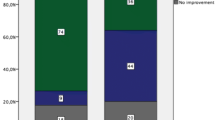Abstract
Purpose
To analyse the clinic-radiological factors associated with neurological deficit following lumbar disc herniation.
Methods
A prospective, cross-sectional study was performed in 140 cases of micro-discectomy following lumbar disc herniation. Group 1 included 70 consecutive patients with motor deficit and group 2 (controls) included 70 patients with intact neurology. Motor deficit was defined as the occurrence of motor power ≤3/5 in L2–S1 myotomes. Multiple clinical and radiological parameters were studied between the two groups.
Results
Patients with diabetes (p 0.004), acute onset of symptoms (p 0.036), L3–4 discs (p 0.001), sequestrated discs (p 0.004), superiorly migrated discs (p 0.012) and central discs (p 0.004), greater antero-posterior disc dimension (p 0.023), primary canal stenosis (p 0.0001); and greater canal compromise (p 0.002) had a significant correlation with the development of neurological deficit. The presence of four or more of these risk factors showed a higher chance of the presence of motor deficit (sensitivity of 74%, specificity of 77%). Age, sex, previous precipitating events, severity of pain, smoking, and number of herniations levels did not affect the occurrence of deficit (p > 0.05 for all). Patients with or without bladder symptoms were similar with respect to all clinico-radiological parameters. However, the time delay since the occurrence of deficit was significantly shorter in patients with bladder involvement (p 0.001).
Conclusion
Patients with diabetes, acute presentation, central, sequestrated and superiorly migrated discs, high lumbar disc prolapse, and greater spinal canal compromise are predisposed to the presence of motor deficit.

Similar content being viewed by others
References
Hoy D, Brooks P, Blyth F, Buchbinder R (2010) The epidemiology of low back pain. Best Pract Res Clin Rheumatol 24(6):769–781
Frymoyer JW (1988) Back pain and sciatica. N Engl J Med 318(5):291–300
Weber H (1983) Lumbar disc herniation: a controlled, prospective study with 10 years of observation. Spine 8(2):131–140
Gibson JNA, Waddell G (2007) Surgical interventions for lumbar disc prolapse: updated Cochrane Review. Spine 32(16):1735–1747
Blamoutier A (2013) Surgical discectomy for lumbar disc herniation: surgical techniques. Orthop Traumatol Surg Res 99(1):S187–S196
Kostuik JP, Harrington I, Alexander D, Rand W, Evans D (1986) Cauda equina syndrome and lumbar disc herniation. J Bone Jt Surg Am 68(3):386–391
Kostuik JP (2004) Medicolegal consequences of cauda equina syndrome: an overview. Neurosurg Focus 16(6):39–41
Sutheerayongprasert C, Paiboonsirijit S, Kuansongtham V, Anuraklekha S, Hiranyasthiti N, Neti S (2012) Factors predicting failure of conservative treatment in lumbar-disc herniation. J Med Assoc Thai 95(5):674
Cribb GL, Jaffray DC, Cassar-Pullicino VN (2007) Observations on the natural history of massive lumbar disc herniation. Bone Jt J 89(6):782–784
Bozzao A, Gallucci M, Masciocchi C, Aprile I, Barile A, Passariello R (1992) Lumbar disk herniation: MR imaging assessment of natural history in patients treated without surgery. Radiology 185(1):135–141
Iizuka Y, Iizuka H, Tsutsumi S, Nakagawa Y, Nakajima T, Sorimachi Y et al (2009) Foot drop due to lumbar degenerative conditions: mechanism and prognostic factors in herniated nucleus pulposus and lumbar spinal stenosis. J Neurosurg Spine 10(3):260–264
Gitelman A, Hishmeh S, Morelli BN, Joseph SA Jr, Casden A, Kuflik P et al (2008) Cauda equina syndrome: a comprehensive review. Am J Orthop (Belle Mead NJ) 37(11):556–562
Lavy C, James A, MacDonald JW, Fairbank J (2009) Cauda equina syndrome. Br Med J 338:881–884
Weinstein JN, Tosteson TD, Lurie JD, Hanscom B, Skinner JS, Abdu WA et al (2006) Surgical vs nonoperative treatment for lumbar dis herniation. the spine patient outcome research trial (SPORT): a randomised trial. JAMA 296(20):2441–2450
Haugen AJ, Brox JI, Grovle L, Kellers A, Natvig B, Soldal D et al (2012) Prognostic factors for non-success in patients with sciatica and disc herniation. BMC Musculoskelet Disord 13:183
Nascone JW, Lauerman WC, Wiesel SW (1999) Cauda Equina syndrome: is it a surgical emergency? Univ Pa Orthop J 12:73–76
Simpson JM, Silveri CP, Balderston RA, Simeone FA, An HS (1993) The results of operations on the lumbar spine in patients who have diabetes mellitus. J Bone Jt Surg Am 75(12):1823–1829
Sakellaridis N (2006) The influence of diabetes mellitus on lumbar intervertebral disk herniation. Surg Neurol 66(2):152–154
Epstein NE (2002) Foraminal and far lateral lumbar disc herniations: surgical alternatives and outcome measures. Spinal Cord 40(10):491–500
Ahn Y, Lee SH, Park WM, Lee HY, Shin SW, Kang HY (2004) Percutaneous endoscopic lumbar discectomy for recurrent disc herniation: surgical technique, outcome, and prognostic factors of 43 consecutive cases. Spine 29(16):E326–E332
Dora C, Wälchli B, Elfering A, Gal I, Weishaupt D, Boos N (2002) The significance of spinal canal dimensions in discriminating symptomatic from asymptomatic disc herniations. Eur Spine J 11(6):575–581
Lurie JD, Faucett SC, Hanscom B, Tosteson TD, Ball PA, Abdu WA et al (2008) Lumbar discectomy outcomes vary by herniation level in the Spine Patient Outcomes Research Trial. J Bone Jt Surg Am 90(9):1811–1819
Shapiro S (1993) Cauda equina syndrome secondary to lumbar disc herniation. Neurosurgery 32(5):743–747
Suzuki A, Matsumura A, Konishi S, Terai H, Tsujio T, Dozono S, Nakamura H (2011) Risk factor analysis for motor deficit and delayed recovery associated with L4/5 lumbar disc herniation. J Spinal Disord Tech 24(1):1–5
Kalemci O, Kizmazoglu C, Ozer E, Arda MN (2013) Lumbar disc herniation associated with contralateral neurological deficit: can venous congestion be the cause? Asian Spine J 7(1):60–62
Acknowledgements
Funding was provide by Ganga Orthopaedic Research and Education Foundation, Coimbatore, India.
Author information
Authors and Affiliations
Corresponding author
Ethics declarations
Conflict of interest
None.
Ethical standards
The study was approved by the institutional review board. The study was conducted in accordance with 1964 Helsinki declaration and its later amendments or comparable ethical standards.
Rights and permissions
About this article
Cite this article
Krishnan, V., Rajasekaran, S., Aiyer, S.N. et al. Clinical and radiological factors related to the presence of motor deficit in lumbar disc prolapse: a prospective analysis of 70 consecutive cases with neurological deficit. Eur Spine J 26, 2642–2649 (2017). https://doi.org/10.1007/s00586-017-5019-5
Received:
Revised:
Accepted:
Published:
Issue Date:
DOI: https://doi.org/10.1007/s00586-017-5019-5




